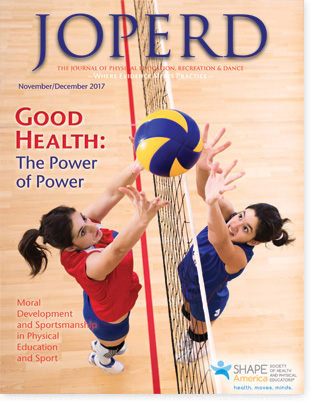 JOPERD Table of Contents
JOPERD Table of Contents
Good Health: The Power of Power
Charles B. Corbin, Kathleen F. Janz, & Fatima Baptista

Power is a word with multiple meanings. It is a word that can be used to describe one of the many components of physical fitness, to refer to the possession of influence or control (political power) or to a source of energy (electric or solar power; Corbin & Le Masurier, 2014). Power, when used to define a fitness component, is commonly described as explosive strength or the ability to exert strength quickly (strength × speed; U.S. Department of Health and Human Services [USDHHS], 1996; Corbin, Pangrazi, & Franks, 2000; Corbin, Welk, Corbin, & Welk, 2016). This article will focus on power, the component of physical fi tness, and how it relates to good health, primarily in youth. Methods of assessing power in field settings such as physical education classes, athletic programs, and community sports will also be discussed.
Power is not new as a component of physical fitness. Nearly 100 years ago, Superman was born and celebrated in post-Depression comic books. Superman was “faster than a speeding bullet, more
powerful than a locomotive, and able to leap buildings in a single bound” (Superman Home Page, www.supermanhomepage.com). Superman exhibited power that enabled him to have a high level
of performance (e.g., sprinting, jumping, throwing). And although he popularized the concept of power, he was years behind physical educators in understanding its importance for health.
In the late 1880s physical educators identified muscle fitness, including power, as important for health. These early leaders were medical doctors (Institute of Medicine [IOM], 2012, p. 24), and
their medical background no doubt led them to focus on health as a primary reason for being fit. In the early 1900s, for example, Dudley Sargent developed a vertical jump test he considered to be
a general measure of fitness and health. The vertical jump test, or “Sargent jump,” is still used today as a measure of muscle power. The Sargent jump was championed as a health-fitness test in Sargent’s books, Universal Test for Strength, Speed and Endurance of the Human Body (Sargent, 1902) and Health, Strength and Power (Sargent, 1904/1914).
To read the rest of this article,
click here to download a pdf.